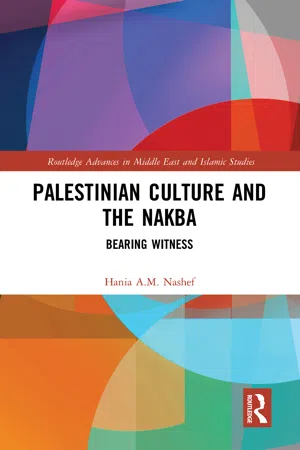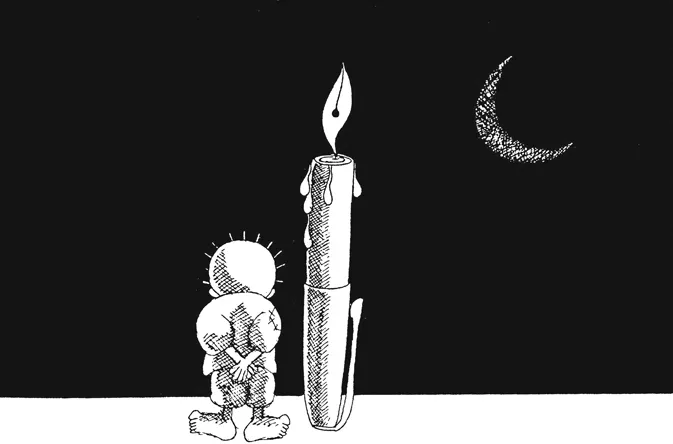![]()
Introduction: the short life of the artist
The defiant and vulnerable little boy, who gazes at scenes of oppression, hypocrisy, injustice, and war, was born in Kuwait in 1969.2 His creator Naji al-Ali was born circa 1936 in al-Shajara (The Tree) in northern Palestine, a village believed to have acquired its name because the Messiah rested under its trees.3 In 1948, Naji al-Ali’s family was expelled to Lebanon to begin a life of exile in Ein el-Helweh Refugee Camp.4 The camp, according to UNRWA, “was established near the city of Sidon in 1948 by the International Committee of the Red Cross to accommodate refugees from Amqa, Saffourieh, Shaab, Taitaba, Manshieh, al-Simireh, al-Nahr, al-Sofsaf, Hitten, Ras al-Ahmar, al-Tiereh and Tarshiha in northern Palestine” (Ein el Hilweh). In the camp, al-Ali and his family lived in a tent that was less than ten square meters.5 The tents, which were composed of cloth, became the canvas onto which al-Ali drew his first illustrations.6 The Palestinian author and journalist Ghassan Kanafani discovered al-Ali’s talent when he saw the latter’s drawings on the walls of the refugee camp;7 Kanafani later published al-Ali’s cartoons in Al-Huriyya literary magazine.8 This was the beginning of a career that took the artist to Kuwait, Lebanon and finally the United Kingdom. His satirical drawings attacking corruption, abuses of human rights, injustice, and lack of democracy were published in both the right and left-wing press (Abid).9 His life ended when a lone assailant shot him in the head as he was heading to his office in the London bureau of Al-Qabas newspaper in 1987.10 His cartoons sadly paved the way to his untimely death.11
American journalist Victor Navasky writes that he initially dismissed “cartoons and caricatures as fundamentally ‘not serious;’ ‘inconsequential,’ ‘irrelevant,’ ‘marginal,’ ‘harmless,’ ‘frivolous,’ ‘a benign—even childish—indulgence,’” but having witnessed people’s reactions to them changed his mind, and he understood their power (xiv). Caricatures in effect can interpret “nations, figures and events,” by helping to “supplement the news presentation” with “statements of ‘meaning’” by putting everything in context (Streicher 438). The assassination of al-Ali was in essence “to silence the witness and extinguish flames of resistance,” as like his fellow compatriots who succumbed to the same fate, al-Ali had taken it upon himself not only to bear witness to “an unspeakable past,” but also to resist the dominant history of silencing (Hamdi 23).12 His cartoons gave the downtrodden agency. Not only did al-Ali construct the refugee narrative successfully but he also “transformed the image of Palestinian refugees from helpless destitute people, who lived in tents and shacks and depended on United Nations rations for survival, into revolutionaries who took their fate into their own hands” (Najjar 258). The cartoonist achieved the latter through the help of his creation, Hanthala. His cartoons avoided clichés, as he held on to the broken image of the little boy inside of him, and the memory of the time the child and his family were expelled from Palestine (Haugbolle 232).
Hanthala: birth of the eternal boy
Even after the assassination of al-Ali, Hanthala continues to tell the Palestinian story (Hamdi 30), reproduced and given a new lease on life with every new artifact or drawing that bears his name. To the cartoonist, Palestine became a symbol for any human being seeking democracy, freedom and justice (al-Ali, “Interview 2”). Al-Ali had an unflinching belief in freedom, and he compared the lack of freedom to living in a matchbox, often questioning how an artist is capable of breathing in a place that is so small (Abid). Through his drawings, he felt he has been in every Arab prison and wondered what else awaited him (Abid). His creations grew out of an uneasy space that he and his people were forced to occupy, from one exile to another, resulting in the uncomfortable juxtaposition of the inner self and the banished self (Boujdidi 196). In some respect, his illustrations occupied a place in the public sphere, “a warning system with sensors” that not only detected societal ills but also amplified them (Habermas 359). He effectively used the public sphere by creating “a network for communicating information and points” through his cartoons (Habermas 360).
Jürgen Habermas argues that the public possesses the final authority, for it “is constitutive for the internal structure and reproduction of the public sphere, the only place where actors can appear” and there “can be no public sphere without a public” (364). Al-Ali’s cartoons struck a chord with the Arab masses because if communication is to be effective it has to encompass “those who are potentially affected” (Habermas 365; emphasis in original). Moreover, al-Ali’s work has successfully managed to brand “its subject” and float it “into the public sphere” (Navasky 35). By being in every al-Ali cartoon since his inception, Hanthala occupies the space that allows him to engage with the public sphere. Hanthala evolved into the boy whom everyone cherished and waited for in every morning paper. Through his observation and silent comments, he dared to pinpoint the injustices towards the Palestinians in particular, the subaltern in general and the overall failures of humanity. In Figure 1.1, for instance, Hanthala, in his usual defiant position, looks at a very black sky; the only hope in this gloom lies with the checkered crescent on the right-hand side of the illustration. The black and white squares, which are also the colors of the Palestinian headdress, evoke the unattainable homeland. The pen next to Hanthala stands nearly double the size of the little boy, with its nib in the shape of a candle flame, pointing to the sky. The flame drips on the sides of the pen in the shape of tears; both Hanthala’s feet and the pen are anchored in the white background, indicating that they not only occupy the only bright space of the cartoon but are also the only hope in this darkness. The dark sky envelops all, and Hanthala along with his creator are the two that are challenging this metaphysical gloom.13
Al-Ali’s public comprises the poor, trodden and marginalized people in the Arab world. His cartoons were also an unwelcome reminder to some whom he criticized often in his work. As his illustrations voiced the disenchantment of millions, simply by mirroring their “personal life experiences,” their problems became eerily visible in his creations (Habermas 365). His brainchild Hanthala evolved to become “the conscience of Palestine” (Masalha 128). In addition, the sum of the artist’s work showed “how political events morphed Palestinians from refugees to revolutionaries”; he gave them dignity (Najjar 256). The cartoons of the Palestinian artist also represented public opinion in the Arab world. Al-Ali’s cartoons, which “were full of hopes, dreams, and a vision for a better life for the Palestinians in particular and for the Arab people in general […] were made for the ordinary Arab person, whether highly educated or illiterate” (Zanetti). The cartoons were published in Kuwait, Lebanon, United Arab Emirates and the United Kingdom; some were:
The cartoons themselves are still as relevant as the day they were published, and Hanthala remains the observer to the trials of his people and the rest of the Arab world. The iconic and symbolic reproductions of the little boy continue to give him life, a new birth with every replica. The little boy is not only the silent witness to the ordeals of the Palestinians but also the companion to many as he epitomizes their hope and resistance. In June 2012, the Ghassan Kanafani Group from the city of Acre (‘Akka) created Hanthala statues in the sand and set up an exhibition of the cartoons to introduce the little boy to young Palestinian children; the event was filmed on the beach of Acre while the editing was done in the refugee camp of al-Dheisheh, which is located south of the city of Bethlehem in the West Bank (“Handala ‘Akka”). Hanthala’s model was carved face down in the sand as he was paired with a map of the city of Acre. Another place in which Hanthala thrives is in the drawings of the refugees on the walls of al-Dheisheh refugee camp; the walls are adorned with reproductions of al-Ali’s cartoons as a way to keep the memory of Hanthala and Palestine alive (Dheisheh-al-Ali). In one of the drawings, however, Hanthala is now an old man holding the hands of two young Hanthalas symbolically facing the separation wall (“Handala Painting”). They are at once looking and leading the old Hanthala to his homeland in Galilee. Likewise in the occupied West Bank, owning a collection of al-Ali cartoons distinguished the person; and the “jouissance, enjoyment, surrounding al-Ali consisted equally in the collecting, the comparing, and the quoting of his cartoons, as well as the feelings of familiarity and proud sumud that his work stoke...

